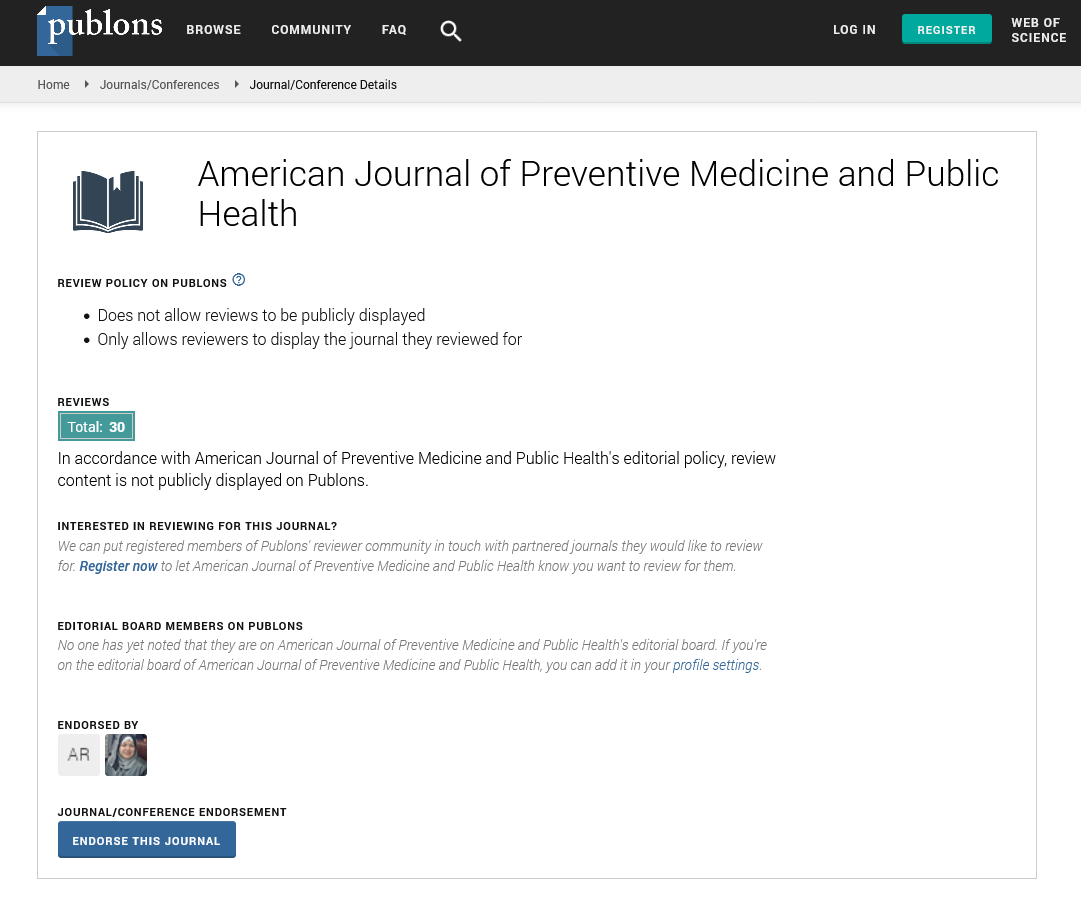Commentary - American Journal of Preventive Medicine and Public Health (2023)
Preventive Chemotherapy: A Multifaceted Approach to Improving Health and Well-being
Myeong Cho*Myeong Cho, Department of Physical Sciences, University of Central Missouri, Warrensburg, USA, Email: myeongcho@yahoo.com
Received: 03-Feb-2023, Manuscript No. AJPMPH-23-93024; Editor assigned: 07-Feb-2023, Pre QC No. AJPMPH-23-93024 (PQ); Reviewed: 21-Feb-2023, QC No. AJPMPH-23-93024; Revised: 28-Feb-2023, Manuscript No. AJPMPH-23-93024 (R); Published: 04-Mar-2023
Description
Preventive chemotherapy is a medical intervention aimed at reducing the burden of neglected tropical diseases (NTDs) by treating at-risk populations with safe and effective medicines. These diseases, which include lymphatic filariasis, onchocerciasis, schistosomiasis, soil-transmitted helminths, and trachoma, affect over a billion people worldwide, particularly those living in impoverished areas with inadequate access to clean water and sanitation.
Preventive chemotherapy has been implemented as a global strategy for NTD control, with the goal of achieving disease elimination by 2030. The approach involves large- scale administration of anthelminthic drugs to entire populations, including preschool-aged children, school-aged children, and adults, depending on the disease prevalence and epidemiology.
The benefits of preventive chemotherapy are multifaceted. Firstly, it helps to reduce the morbidity and mortality associated with NTDs, which can have a profound impact on affected individuals, families, and communities. Secondly, it can improve the overall health and well-being of populations by alleviating symptoms, improving nutrition, and reducing the risk of other health problems associated with NTDs. Finally, it can also enhance economic productivity and social development by reducing the burden of disease and disability.
The success of preventive chemotherapy depends on several factors, including drug efficacy, compliance, and coverage. It is essential to use safe and effective medicines, such as albendazole, ivermectin, praziquantel, and azithromycin, and to ensure that they are delivered at the appropriate doses and intervals. Compliance with treatment is also critical, as failure to complete the full course of medication can result in treatment failure and drug resistance. Moreover, achieving high coverage rates is essential to reach a significant proportion of the population and interrupt the transmission of NTDs.
Preventive Chemotherapy (PC) is a strategy aimed at controlling or eliminating certain Neglected Tropical Diseases (NTDs) through the administration of drugs to entire populations at risk, regardless of whether they are infected or not. This approach is particularly important for diseases that are difficult to diagnose and treat, as well as for communities with limited access to healthcare.
NTDs are a group of parasitic and bacterial infections that affect more than one billion people worldwide, mostly in low-income countries. They cause a range of debilitating symptoms, including chronic pain, disability, disfigurement, and stunted growth, and can even be fatal in some cases. PC is a cost-effective and efficient way to prevent and treat these diseases, and it has been endorsed by the World Health Organization (WHO) as a key strategy for their control and elimination.
Preventive Chemotherapy (PC) is a strategy that aims to control and eliminate the transmission of certain Neglected Tropical Diseases (NTDs) through the mass administration of safe and effective drugs to at-risk populations. These diseases, such as lymphatic filariasis, onchocerciasis, schistosomiasis, soil-transmitted helminths, and trachoma, affect millions of people in low- and middle-income countries, especially those living in rural areas with limited access to clean water and sanitation.
PC has been a game-changer in the fight against NTDs, reducing morbidity and mortality, improving the quality of life of affected communities, and contributing to poverty reduction and economic growth. The administration of PC is usually done once or twice a year, depending on the disease and the epidemiological situation, and targets entire communities, including preschool-aged children, school- aged children, and adults.
The success of PC depends on several factors, including the availability and quality of drugs, the capacity of health systems to deliver the drugs to the population, the involvement of communities and other stakeholders in the planning and implementation of the program, and the monitoring and evaluation of the impact of the intervention.
While PC has been widely recognized as a cost-effective and efficient strategy, it also faces several challenges that need to be addressed. These challenges include drug resistance, low coverage and compliance rates, insufficient funding and resources, inadequate surveillance and response systems, and the need to integrate PC with other health interventions and services.
To overcome these challenges and sustain the gains achieved through PC, there is a need for increased investment in research and development of new and improved drugs, innovative delivery mechanisms, and stronger health systems.
There is also a need to strengthen the partnerships and collaborations among governments, donors, civil society, and the private sector to mobilize resources and support for PC programs.
In conclusion, preventive chemotherapy is a crucial strategy for controlling and eliminating NTDs, and it has demonstrated significant success in reducing the burden of disease in many countries. Continued efforts are needed to ensure that preventive chemotherapy programs are sustained, adequately funded, and integrated with other health and development initiatives to achieve the ultimate goal of eliminating NTDs as a public health problem and PC is a powerful tool in the fight against NTDs, and its potential to improve the health and well-being of millions of people cannot be overstated. However, sustained efforts and investments are needed to ensure that PC continues to be an effective and sustainable strategy for controlling and eliminating NTDs.
Citation: © 2022 The Authors. This is an open access article under the terms of the Creative Commons Attribution Non Commercial Share Alike 4.0 (https://creativecommons.org/licenses/by-nc-sa/4.0/).







